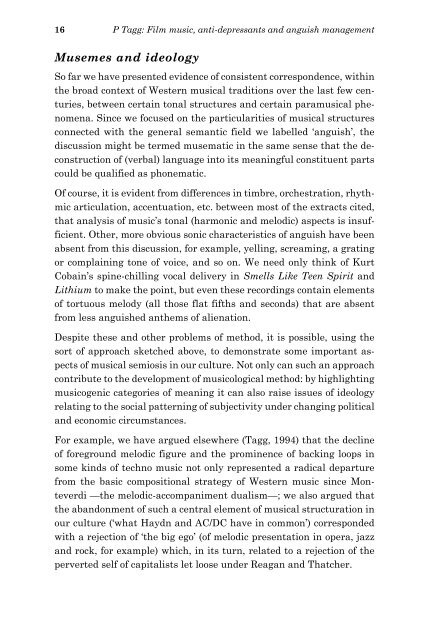Film music, antidepressants and anguish management - Philip Tagg
Film music, antidepressants and anguish management - Philip Tagg
Film music, antidepressants and anguish management - Philip Tagg
You also want an ePaper? Increase the reach of your titles
YUMPU automatically turns print PDFs into web optimized ePapers that Google loves.
16 P <strong>Tagg</strong>: <strong>Film</strong> <strong>music</strong>, anti-depressants <strong>and</strong> <strong>anguish</strong> <strong>management</strong><br />
Musemes <strong>and</strong> ideology<br />
So far we have presented evidence of consistent correspondence, within<br />
the broad context of Western <strong>music</strong>al traditions over the last few centuries,<br />
between certain tonal structures <strong>and</strong> certain para<strong>music</strong>al phenomena.<br />
Since we focused on the particularities of <strong>music</strong>al structures<br />
connected with the general semantic field we labelled ‘<strong>anguish</strong>’, the<br />
discussion might be termed musematic in the same sense that the deconstruction<br />
of (verbal) language into its meaningful constituent parts<br />
could be qualified as phonematic.<br />
Of course, it is evident from differences in timbre, orchestration, rhythmic<br />
articulation, accentuation, etc. between most of the extracts cited,<br />
that analysis of <strong>music</strong>’s tonal (harmonic <strong>and</strong> melodic) aspects is insufficient.<br />
Other, more obvious sonic characteristics of <strong>anguish</strong> have been<br />
absent from this discussion, for example, yelling, screaming, a grating<br />
or complaining tone of voice, <strong>and</strong> so on. We need only think of Kurt<br />
Cobain’s spine-chilling vocal delivery in Smells Like Teen Spirit <strong>and</strong><br />
Lithium to make the point, but even these recordings contain elements<br />
of tortuous melody (all those flat fifths <strong>and</strong> seconds) that are absent<br />
from less <strong>anguish</strong>ed anthems of alienation.<br />
Despite these <strong>and</strong> other problems of method, it is possible, using the<br />
sort of approach sketched above, to demonstrate some important aspects<br />
of <strong>music</strong>al semiosis in our culture. Not only can such an approach<br />
contribute to the development of <strong>music</strong>ological method: by highlighting<br />
<strong>music</strong>ogenic categories of meaning it can also raise issues of ideology<br />
relating to the social patterning of subjectivity under changing political<br />
<strong>and</strong> economic circumstances.<br />
For example, we have argued elsewhere (<strong>Tagg</strong>, 1994) that the decline<br />
of foreground melodic figure <strong>and</strong> the prominence of backing loops in<br />
some kinds of techno <strong>music</strong> not only represented a radical departure<br />
from the basic compositional strategy of Western <strong>music</strong> since Monteverdi<br />
—the melodic-accompaniment dualism—; we also argued that<br />
the ab<strong>and</strong>onment of such a central element of <strong>music</strong>al structuration in<br />
our culture (‘what Haydn <strong>and</strong> AC/DC have in common’) corresponded<br />
with a rejection of ‘the big ego’ (of melodic presentation in opera, jazz<br />
<strong>and</strong> rock, for example) which, in its turn, related to a rejection of the<br />
perverted self of capitalists let loose under Reagan <strong>and</strong> Thatcher.














